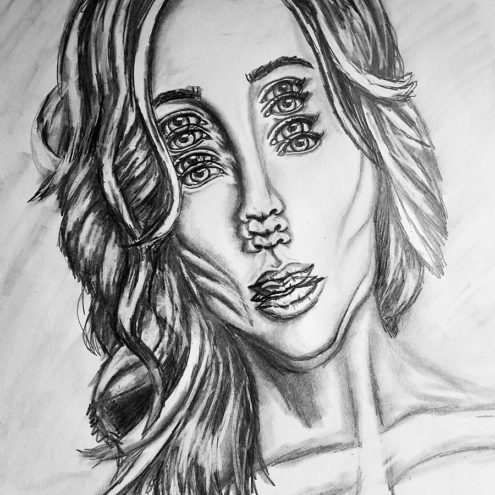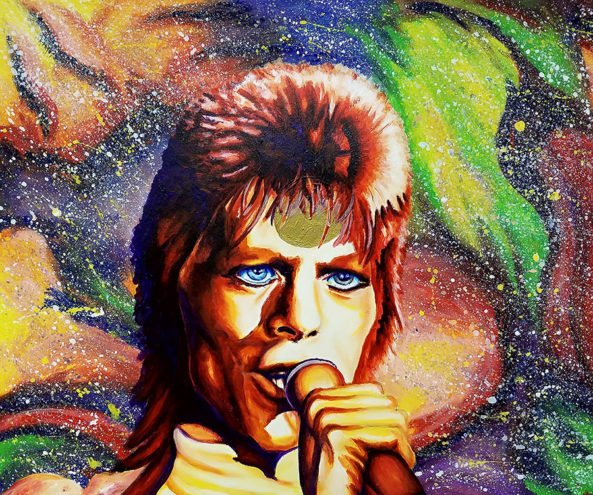Portland Artist Ashley Thomas


ELEVEN: You completed your BA at Marylhurst. What was your degree and how has that education influenced your development as an artist?
Ashley Thomas: I started going to Marylhurst University back in 2014, and I can definitely say that my experience there was life changing. My art education went well beyond color theory or shading; they taught about art community, deeper messages within art, art therapy, etc. I guess before Marylhurst, I only knew how to “see” art, now I know how to “think” like an artist. I also minored in psychology, which really opened my eyes to people; I’m a very shy, introverted person and that caused me to be stuck in my own thoughts and feelings before Marylhurst. Now I know how to effectively listen to others and put more effort into appreciating every person I come across, because everyone is important and worth time. This has inspired me greatly as an artist, and I think that’s why I love doing portraits so much. I’m trying to capture some resemblance of their soul through my perception and experience with that person or their own creations.
11: You’re well known for both your portraits and surreal imagery. Where does the inspiration for your surreal work come from?
AT: My surreal work is a little tricky for me to explain because, if I‘m being honest with myself, I don’t fully understand them. But I do notice common symbolisms or motifs in those works that usually allude to anger and sadness; two very defining emotions in my childhood and teenage years. I grew up in a sheltered home in a materialistic community; not a day didn’t go by where I was not made fun of, teased because of my weight or simply ignored by most. I remember coming home everyday with the same pattern: staring at myself in the mirror as I sobbed and told myself that I was worthless and ugly. I remember getting angry with myself for thinking that way, but how do you escape that inner voice when your peers are saying it back to you? It reached its peak in high school when my sadness turned into complete depression and I stopped feeling at all. I lost contact with my few friends, I stayed in my room all day when I got home and just didn’t care about anything. Luckily, though, my depression stopped when I graduated and started attending a community college in 2012, started listening to music daily and began studying/creating art. My surreal works, I think, represent those years of hurt and despair, but there’s always some form of light and fight within those works as well; showing that I made it through the hardest years of my life.

11: Many of your portraits are of rock legends. Which is your favorite?
AT: I get this question a lot, and it is still very difficult to answer. Picking a favorite painting feels like I’m picking a favorite child [laughs]. But, I guess if I think of a scenario where I am only allowed to keep one painting otherwise something bad is going to happen, then I would pick my Jimi Hendrix. It was one of my first portraits and I love everything about it.
11: You have mentioned that art has been therapeutic and healing for you. Can you elaborate on that a bit?
AT: I like to classify my work as emotional expressionism because I’m usually expressing deep, overwhelming emotion within my works. For my portrait collection of musicians, they are bright and vibrant because that is how I feel when I listen to their music. I’m completely happy and fully immersed when I turn on Nirvana or The Beatles for example, so I try to express that in those paintings. In my darker works, I’m expressing more negative emotions, which means I have to deal with those feelings while I paint or draw those images. This is very healing and therapeutic because I’m essentially forcing myself to process and release those emotions, thus leaving me in a better mood and state of mind afterward. I think it’s also healing to be able to take negative energy and transform it into a work of art.

11: You both paint and sketch. What is your favorite medium?
AT: I love painting and the variety of color and stylistic options it offers, but I often pick up my pencils more than my brushes. Sketching comes naturally to me because I’ve been doing it since I can remember. I think I still have a lot left to learn when it comes to painting, so that can stress me out from time to time.
11: Both Goya and Dali are inspirations for you. How does their work inspire what you create? What of them do you fold into your pieces?
AT: It’s so hard to talk about these artists and not write an entire essay about them, but to summarize, I love these artists because they both pushed the boundaries of art through very unique, shocking and brutally honest styles and imagery. What I would love to incorporate more from Goya is his honesty and intent to spread a message. Whether that message is about political plights or more personal, internal struggle, I just really want to develop what I’m saying within my artworks. What I am so inspired by from Dali is his amazing artistic skill and larger than life persona. I would love to create artwork that is so different, so shocking and yet so beautiful that everyone is left speechless, similar to Dali’s surrealist paintings and films. Both artists and their immense bodies of work just push me to be better and to keep challenging myself.

11: Can you tell us a little about your latest installation? What was the imagery and creative process?
AT: Last year, for a final project, we were asked to make an installation about anything we wanted. I immediately had a grandiose vision of a dark, ominous space that incorporated creepy sound and special lighting. There would be a wall that had a giant, 3D face with its mouth open and with dark, shiny liquid coming out of its mouth. The liquid would then pool in the middle of the space and begin to morph upward into metal and wood that creates a kinetic sculpture of a creature. As much as I wanted this vision to come to fruition, I was awakened by the fact that we only had three weeks to complete this installation and I remembered that I am poor and could not possibly afford the required materials for such a project [laughs]. Instead, my installation consisted of a 9 x 9 foot charcoal drawing of a screaming face on a wall within an empty dorm room. From the mouth, I laid bundles of branches, sticks and scraps of torn paper that lead out and gathered in the middle of the room. I then created a dino/horse looking creature out of branches and wire. Now, my final work was nothing like what I had originally envisioned, but I was proud of it nonetheless! I definitely plan on revisiting this and other ideas of mine in the future!
11: You’ve mentioned that your goal is to get your masters and become a teacher. What age groups do you like working with and what draws you to teach?
AT: My urge to teach art stems from my own varying experiences with teachers in my past. A lot of art teachers that I’ve had usually fell into one (or more) of three bad qualities: lazy with students, unenthusiastic about art, or graded/critiqued based on their own personal tastes. I’ve had a number of teachers who didn’t care about my representational style because they were more abstract in their own work. I’m not saying that they needed to love my work, but they needed to interact with me and challenge me to develop (that’s the whole point of taking a class); but I felt ignored and like some classes were a waste of time because of those types of teachers. I’ve also had many teachers (beyond art) who just didn’t seem to care about what they were teaching, basically leaving me feeling like I didn’t need to care about that subject. Overall, I do feel an urge to become an art teacher just so that I can be the teacher that I always wanted: someone who is enthusiastic, treats each student equally and someone who challenges them to develop and push their artistic boundaries. If I do become a teacher, I will want to work with either high school students or at college level.

11: On the path to your masters, you stated that you wanted to become a tattoo artist. What makes you choose that medium over others?
AT: This is a very new goal of mine and I am very excited to pursue it soon. When I think about what it is I’m trying to do in my work (express emotion, capture resemblance of life, soul, etc.), I think tattooing would be a great medium for me to try out. There’s something very sacred about tattoos. I mean, a person is choosing or creating a design to be needled into their skin forever because it usually represents something very personal. I would love to be able to create these meaningful designs for people and to hear their stories. I love listening to people, and what better way to experience that than in a tattoo shop as I give them a gift of identity and unique expression. It’s hard to explain because this is all new to me, but being a tattoo artist just feels right and like the next step in my development as an artist. It will be a challenging journey, but one that I would enjoy every second of!




